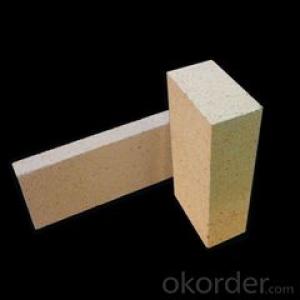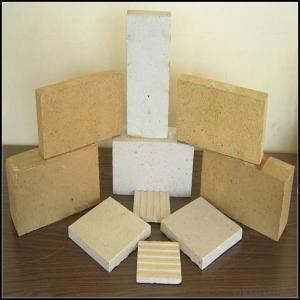Insulating Fire Brick - High Alumina Insulating Firebrick for Sale
- Loading Port:
- Shanghai
- Payment Terms:
- TT OR LC
- Min Order Qty:
- 1 m.t.
- Supply Capability:
- 1000000 m.t./month
OKorder Service Pledge
OKorder Financial Service
You Might Also Like
Features:This product used super alumina as mainly raw material,adopted the burning weight-loss method to produce
with proper admixture.
Application:Widely used in metallurgy,machinery,ceramic,chemical industry and various furnace lining(Don't suffer the meltwater eroding),and it is an ideal energy-saving product.Using temperature below 1400°C.
Item | Properties | ||||
LTL-0.6 | LTL-0.8 | LTL-1.0 | LTL-1.2 | ||
Bulk density,g/cm3 | 0.6 | 0.8 | 1.0 | 1.2 | |
Cold Crushing strength MPa | 2.0 | 3.98 | 4.98 | 5.98 | |
Permanent linear change,2%(°C×h) | 1350×12 | 1400×12 | 1400×12 | 1400×12 | |
Coefficient of thermal conductivity w/m.k(350±25°C) | 0.25 | 0.29 | 0.35 | 0.45 | |
Fe2O3% | 1.8 | 1.8 | 1.8 | 1.8 | |
AL2O3% | 50 | 50 | 55 | 55 | |
Application | All industrial furnace | ||||

Application of Insulating Firebricks
CMAX insulating firebricks can be used as a hot face lining directly exposed to the heat or as a backup insulation layer in iron and steel mills, non-ferrous foundries, petrochemical, ceramic, glass.
FAQ
Q1: How do you control the products quality?
A1: With strict quality control system throughout the materials selection and production process, our refractory and ceramic fiber products quality is effectively controlled to meet customer requirements.
From the raw materials selecting, our quality control begin. The quality certificates of raw materials are required and each batch will be tested before using. During production, the quality control are conducted by workers and then each piece will be sorted and examined by quality supervis
Q2: What`s the lead time for my order?
A2: It depends on customers’ requirements and our production schedule. And usually we need 30-60 days for refractory bricks,10-25 days for unshaped refractory materials and 10-20 days for ceramic fiber blankets.
- Q: Can insulating fire bricks be used in the construction of refractory-lined vessels?
- Insulating fire bricks have the capability to be utilized in the construction of vessels lined with refractories. These bricks are specially designed to possess low thermal conductivity, making them an ideal choice for applications that require insulation. When constructing refractory-lined vessels, insulating fire bricks are commonly placed in the outer layers of the lining to offer insulation and minimize heat loss. This contributes to enhanced energy efficiency and the maintenance of high temperatures within the vessel. Nevertheless, it is essential to consider that insulating fire bricks may not be suitable for all sections of the refractory lining, particularly in areas where high mechanical strength or resistance to chemical attack is necessary. In such instances, alternative types of refractory bricks may be necessary.
- Q: Can insulating fire bricks be used as insulation in walls and roofs?
- Yes, insulating fire bricks can be used as insulation in walls and roofs. They have excellent thermal insulation properties, high heat resistance, and are specifically designed for use in high-temperature environments.
- Q: Can insulating fire bricks be used in chimneys and flues?
- Insulating fire bricks are designed specifically for high-temperature usage and are commonly employed in industrial settings, furnaces, and kilns. While they possess exceptional insulating properties, they may not be the optimal choice for chimneys and flues in residential or commercial buildings. The primary reason for this is that insulating fire bricks lack the durability and heat resistance found in other materials specifically designed for chimney and flue construction. They have the potential to crack or break when subjected to the extreme heat and rapid temperature fluctuations that occur in chimneys. Moreover, these bricks are not typically engineered to withstand the corrosive effects of flue gases, which can result in their degradation over time. When dealing with chimneys and flues, it is generally recommended to utilize materials like clay flue liners, stainless steel, or refractory bricks that are specifically manufactured for these purposes. These materials are better equipped to handle the elevated temperatures, corrosive gases, and rapid thermal expansion and contraction that are inherent to chimneys. It is crucial to consult a professional chimney or flue specialist who can provide guidance on the suitable materials to employ based on the specific requirements and conditions of your chimney or flue system.
- Q: Do insulating fire bricks require any special storage conditions?
- Insulating fire bricks do not require any special storage conditions. These bricks are designed to withstand high temperatures and are typically made from materials such as clay or silica that are resistant to heat. However, it is always recommended to store insulating fire bricks in a dry and covered area to prevent any moisture absorption or damage. Additionally, it is important to handle these bricks with care to avoid any breakages or cracks that may affect their insulation properties. Overall, as long as the bricks are stored in a dry and protected environment, there are no specific special storage conditions required for insulating fire bricks.
- Q: Can insulating fire bricks be used in boilers for steam generation?
- Yes, insulating fire bricks can be used in boilers for steam generation. Insulating fire bricks have excellent thermal insulation properties, which help to minimize heat loss and increase the overall energy efficiency of the boiler. Additionally, their high temperature resistance makes them suitable for the high heat and pressure conditions present in steam generation applications.
- Q: Can insulating fire bricks be used in the construction of combustion flues?
- Yes, insulating fire bricks can be used in the construction of combustion flues. Insulating fire bricks are designed to withstand high temperatures and are often used to line combustion chambers and flues to provide insulation and prevent heat loss. They have excellent thermal properties, making them suitable for this purpose.
- Q: Can insulating fire bricks be used for insulation in heat exchangers?
- Insulation in heat exchangers can be achieved by utilizing insulating fire bricks. These bricks are constructed from a lightweight refractory material that boasts exceptional thermal insulation properties. With their low thermal conductivity, insulating fire bricks effectively minimize heat transfer between the two sides of the heat exchanger. Consequently, they aid in maintaining the desired temperature within the heat exchanger and prevent heat loss to the surroundings. Furthermore, the durability of these bricks is evident as they can endure high temperatures and thermal shocks, making them ideal for the harsh conditions typically encountered in heat exchangers. In summary, incorporating insulating fire bricks into heat exchangers not only enhances energy efficiency and reduces heat loss but also improves the overall system performance.
- Q: Are insulating fire bricks suitable for use in steel mills?
- Yes, insulating fire bricks are suitable for use in steel mills. Insulating fire bricks are made from lightweight materials that have high insulating properties, allowing them to withstand high temperatures and provide effective insulation. In steel mills, where extremely high temperatures are generated during the steelmaking process, insulating fire bricks are used to line furnaces, kilns, and other high-temperature applications. These bricks help to reduce heat loss, improve energy efficiency, and protect the steel mill equipment from excessive heat. Additionally, insulating fire bricks have good thermal shock resistance, which is essential in steel mills where rapid temperature changes occur. Overall, the use of insulating fire bricks in steel mills is a reliable and effective solution for maintaining high-temperature environments and optimizing the steelmaking process.
- Q: Can insulating fire bricks be used in crucibles?
- Yes, insulating fire bricks can be used in crucibles. Insulating fire bricks are designed to withstand high temperatures and provide excellent insulation, making them suitable for use in crucibles where extreme heat is required.
- Q: Can insulating fire bricks be used for pizza ovens?
- Yes, insulating fire bricks can be used for pizza ovens. These bricks are designed to withstand high temperatures and provide excellent insulation, making them an ideal choice for pizza ovens. Insulating fire bricks have low thermal conductivity, which means they can retain heat for longer periods of time, ensuring that your pizza is cooked evenly and efficiently. Additionally, their lightweight nature makes them easy to handle and install in a pizza oven. Overall, using insulating fire bricks in a pizza oven can help maintain high temperatures, reduce heat loss, and improve the overall cooking performance.
Send your message to us
Insulating Fire Brick - High Alumina Insulating Firebrick for Sale
- Loading Port:
- Shanghai
- Payment Terms:
- TT OR LC
- Min Order Qty:
- 1 m.t.
- Supply Capability:
- 1000000 m.t./month
OKorder Service Pledge
OKorder Financial Service
Similar products
Hot products
Hot Searches
Related keywords




























